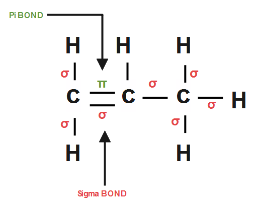
How many sigma and pi bonds are present in propene molecules?
Answer
441.6k+ views
Hint: Here the first thing we get from "propene" usually all bonds between atoms in most of the organic compounds contains one sigma bond each of them. Whenever it is a single bond it contains only sigma bonds. These multiple bonds double and triple however we can understand how it contains sigma and pi bonds. Therefore double bonds have one each and triple bonds have one sigma bond as well as two pi bonds.
Complete step-by-step answer:We all know that propene structural formula is given by \[C{{H}_{2}}=CH-C{{H}_{3}}\]
Propene has \[8\sigma \] sigma bonds ( \[C-C\] bonds and all \[C-H\] bonds) and \[1\pi \] pi bond \[{{C}_{1}}-{{C}_{2}}\]
Whereas
Single Bond = \[8\sigma \] bond.
Double Bond = \[8\sigma \] bond + \[1\pi \] bond.
Triple Bond = \[8\sigma \] bond + \[2\pi \] bond.

So therefore we have \[8\sigma \] sigma bond as well as \[1\pi \] pi bond in a propene molecule.
Note: Note that the \[\pi \] bonding in the orbital is always lower in energy than nonbonding p orbital. Therefore each and every carbon Centre as shown has two electrons in lower energy efficiency and bonding of π orbital the energy of each and every system is being lowered overall and its thus more and more stable, regardless of anion, radical or cation.
Meanwhile the stability of alkyl carbocation is all due to conjugated \[\pi \] electrons. The double bond doesn’t really exist in nature or that environment. Instead of that it is a group of three adjacent, non-hybridized, overlapping p orbitals we call it as a conjugated \[\pi \] electron. We can clearly state that the interaction between all of three p orbitals from three carbon resulting in a really stable cation. It all deprives us of ups and downs to where the location of the electron deficient our carbon atom is.
Complete step-by-step answer:We all know that propene structural formula is given by \[C{{H}_{2}}=CH-C{{H}_{3}}\]
Propene has \[8\sigma \] sigma bonds ( \[C-C\] bonds and all \[C-H\] bonds) and \[1\pi \] pi bond \[{{C}_{1}}-{{C}_{2}}\]
Whereas
Single Bond = \[8\sigma \] bond.
Double Bond = \[8\sigma \] bond + \[1\pi \] bond.
Triple Bond = \[8\sigma \] bond + \[2\pi \] bond.

So therefore we have \[8\sigma \] sigma bond as well as \[1\pi \] pi bond in a propene molecule.
Note: Note that the \[\pi \] bonding in the orbital is always lower in energy than nonbonding p orbital. Therefore each and every carbon Centre as shown has two electrons in lower energy efficiency and bonding of π orbital the energy of each and every system is being lowered overall and its thus more and more stable, regardless of anion, radical or cation.
Meanwhile the stability of alkyl carbocation is all due to conjugated \[\pi \] electrons. The double bond doesn’t really exist in nature or that environment. Instead of that it is a group of three adjacent, non-hybridized, overlapping p orbitals we call it as a conjugated \[\pi \] electron. We can clearly state that the interaction between all of three p orbitals from three carbon resulting in a really stable cation. It all deprives us of ups and downs to where the location of the electron deficient our carbon atom is.
Recently Updated Pages
Can anyone list 10 advantages and disadvantages of friction

What are the Components of Financial System?

How do you arrange NH4 + BF3 H2O C2H2 in increasing class 11 chemistry CBSE

Is H mCT and q mCT the same thing If so which is more class 11 chemistry CBSE

What are the possible quantum number for the last outermost class 11 chemistry CBSE

Is C2 paramagnetic or diamagnetic class 11 chemistry CBSE

Trending doubts
Which is not a source of freshwater 1 Glaciers and class 11 chemistry CBSE

10 examples of friction in our daily life

The correct order of melting point of 14th group elements class 11 chemistry CBSE

Difference Between Prokaryotic Cells and Eukaryotic Cells

One Metric ton is equal to kg A 10000 B 1000 C 100 class 11 physics CBSE

What is the specific heat capacity of ice water and class 11 physics CBSE




